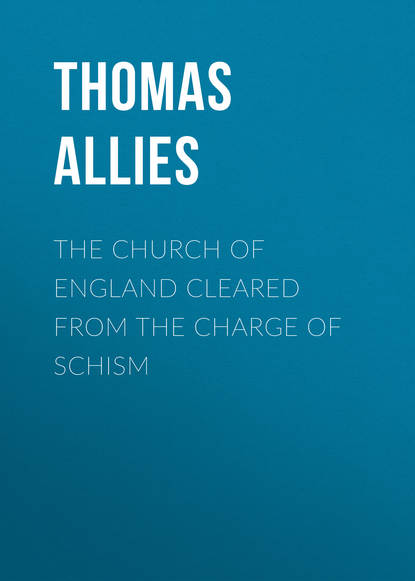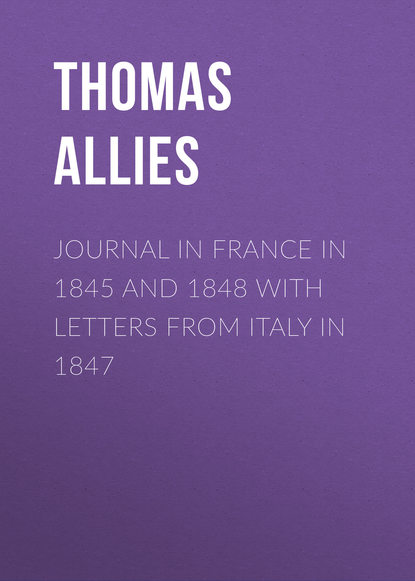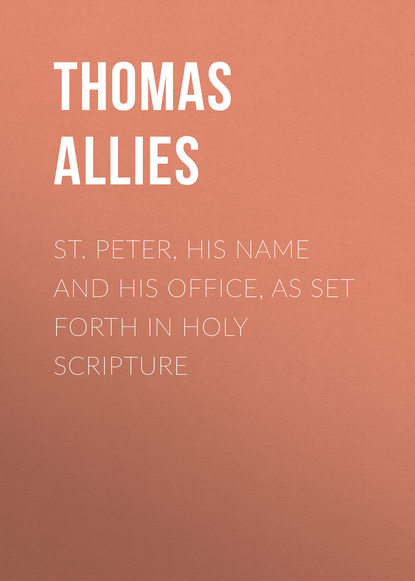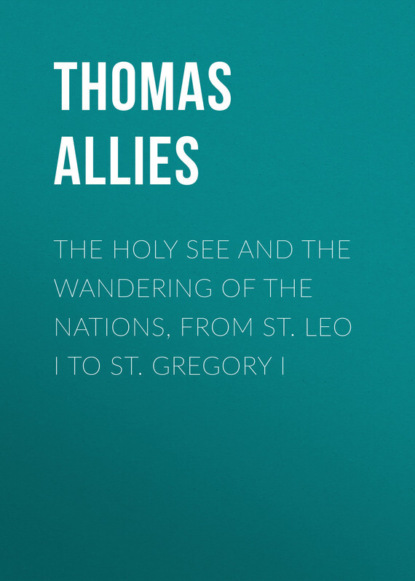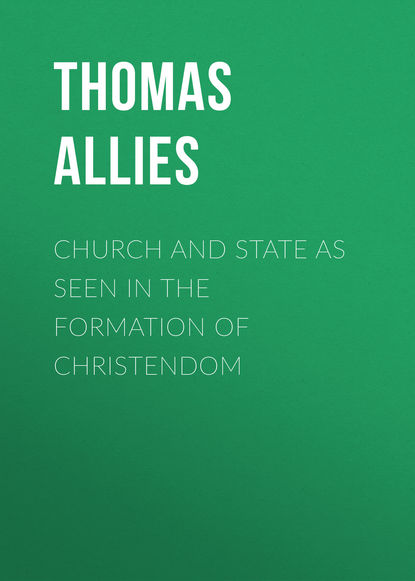
Полная версия
Peter's Rock in Mohammed's Flood, from St. Gregory the Great to St. Leo III

Peter's Rock in Mohammed's Flood, from St. Gregory the Great to St. Leo III
Prologue To The Seven Volumes Of The Formation Of Christendom
This work being from the beginning one in idea, I place here together the titles of the fifty-six chapters composing it. For each of these was intended to be complete in itself, so far as its special subject reached; but each was likewise to form a distinct link in a chain. The Church of God comes before the thoughtful mind as the vast mass of a kingdom. Its greatest deeds are but parts of something immeasurably greater. The most striking evidence of its doctrines and of its works is cumulative. Those who do not wish to let it so come before them often confine their interest in very narrow bounds of time and space. Thus I have known one, who thought himself a bishop, accept Wycliffe as the answer of a child to his question, Who first preached the Gospel in England? And not only this. They also seize upon a particular incident, or person, and so invest with extraordinary importance facts which they suppose, and which so conceived are convenient for their purpose, but in historical truth are anything but undisputed. In this tone of mind, or shortness of vision, that which is gigantic becomes puny, that which is unending becomes transient. The sequel and coherence of nations, the mighty roll of the ages spoken of by St. Augustine, are lost sight of. Again, in English-speaking countries alone more than two hundred sects call themselves Christian. Their enjoyment of perfect civil freedom and equality veils to them the horror of doctrinal anarchy, in virtue of which alone they exist. By this anarchy the very conception of unity as the corollary of truth is lost to the popular mind. But through the eight centuries of which I have treated, the loss of unity was the one conclusive test of falsehood, and the Christian Faith stood out to its possessors with the fixed solidity of a mountain range whose summit pierced the heaven.
It has been my purpose to exhibit the profound unity of the Christian Faith together with the infinite variety of its effects on individual character, on human society, on the action of nations towards each other, on universal as well as national legislation. Like the figure of the great Mother of God bearing her Divine Son in her arms, and so including the Incarnation and all its works, the Faith stands before us in history, “veste deaurata, circumdata varietate”. And as the personal unity appears in the symbol of the Divine Love to man expressed in her Maternity, so it appears also in the figure of the Church through the ages in which that Divine Love executes His work. A divided creed means a marred gospel and an incredulous world.
I offer this work as a single stone, though costing the labour of thirty years, if perchance it may be accepted in the structure of that Cathedral of human thought and action wherein our Crucified God is the central figure, around which all has grown.
Be it allowed me to quote here words of the present Sovereign Pontiff addressed on the 18th August, 1883, to the Cardinals de Luca, Pitra, and Hergenröther: —
“It is the voice of all history that God with the most careful providence directs the various and never-ending movements of human affairs. Even against man's intention he makes them serve the advancement of His Church. History says further that the Roman Pontificate has ever escaped victorious from its contests and the violence employed against it, while its assaulters have failed in the hope which they cherished, and have wrought their own destruction. Not less openly does history attest the divine provision made concerning the city of Rome from its very beginning. This was to give for ever a home and seat to the successors of St. Peter, from which as a centre, being free from all control of a superior, they might guide the whole Christian commonwealth. And no one has ventured to resist this counsel of the divine Providence without sooner or later perceiving the vanity of his efforts.
“It cannot be expedient, nor is it wise counsel, to fight with a power for whose perpetuity God has pledged Himself, while history attests the performance of the pledge. Since Catholics throughout the whole world pay it religious veneration, it is their interest to defend it with all their power. Nay even the rulers of secular governments must acknowledge this, and lay it to heart, especially in times so dangerous, when the very foundations on which human society rests appear well nigh to shake and totter.”
Preface
This volume is strictly in continuance of the two which it follows – “The Throne of the Fisherman built by the Carpenter's Son,” and “The Holy See and the Wandering of the Nations”. It is bulk alone which prevents my offering the three in one cover as historic proof, from original documents, of the first eight centuries that the Holy See by the institution of Christ is the Root, the Bond, and the Crown of Christendom. The works chiefly used in it are before and above all the letters of the Popes in their office of governing the Christian Commonwealth, which are contained in the great collection of Mansi, thirty-one volumes folio. The full titles of other works chiefly referred to are Cardinal Hergenröther, to whose work, Photius, Patriarch von Constantinopel, sein Leben, seine Schriften, und das griechische Schisma, and to his Handbuch der allgemeinen Kirchengeschichte, I owe great obligations – they are each in three volumes; Alfred von Reumont, Geschichte der Stadt Rom, in three volumes; Gregorovius, Geschichte der Stadt Rom, in eight volumes; Kurth, Les origines de la Civilisation moderne, in two volumes; Jungmann, Dissertationes, in seven volumes; the German edition of Rohrbacher's History, vol. x. by Rump, vol. xi. by Kellner; Hefele, Concilien-Geschichte, in seven volumes; Muratori, Annali d'Italia; Brunengo, Le Origini della Sovranità Temporale dei Papi, and I primi Papi-Re e l'ultimo Re dei Longo-bardi; F. von Hoensbroech, Enstehung und Entwicklung des Kirchenstaates; Niehues, Kaiserthum und Papstthum, Döllinger, Muhammed's Religion, nach ihrer inneren Entwicklung und ihrem Einflusse auf das Leben der Völker. Regensburg, 1838.
Chapter I. The Pope And The Byzantine
I have hitherto conducted the history of the Throne of the Fisherman built by the Carpenter's Son in unbroken succession from St. Peter to St. Gregory the Great. It is a period of 575 years from the Day of Pentecost a. d. 29 to St. Gregory's death in a. d. 604. This period is very nearly bisected by the conversion of Constantine. The first half contains the action of the Primacy over against a hostile heathen empire. The second half contains its action upon an empire which, at least in principle, acknowledged union with the Catholic Church as a duty, a privilege, and a necessity. The testimony rendered by Councils and by Fathers to the Roman Primacy may be said to be complete in the time of St. Gregory. Subsequent Councils can only add a closer precision to the testimony of the Council of Chalcedon. Subsequent acts of the Eastern empire can scarcely go beyond the submission of its episcopate, its emperor, and its nobles to Pope Hormisdas. The point of that submission consists in the solemn acceptance of the line of Roman bishops as inheriting the charge given by our Lord to St. Peter. Subsequent legislation can but apply in detail the acceptance by Justinian of the Pope's right to examine everything which belongs to the doctrine or concerns the conduct of the Church throughout the world. And force is even added to this acceptance, because it was made when the Pope, John II., to whom it was made, was not in fact his temporal subject.
I propose to treat in this volume of a period embracing two hundred years. It runs from the time of St. Gregory the Great to the founding of the holy Roman empire, in the person of Charlemagne, by Pope St. Leo III.
But, before entering on this treatment, it seems to me called for to make one remark on all which I have hitherto written or am hereafter to write, and to draw out distinctly a principle which affects every line of my narrative. This is the necessity of considering the Church as the one kingdom of Christ in all ages: one and the same polity from the Day of Pentecost to the Day of Judgment. This idea has always been before me as the rule of faith in writing the six preceding volumes. It has been the major premiss of my whole argument. To a Catholic the unity of the Church is as necessary as the unity of God; and, equally, to say that the Church is fallible is to deny the existence of any such thing as the kingdom of God upon earth. The sooner that anything which is fallible is swept away the better. The one duty which we owe to fallibility is to label it. The thing called public opinion is fallible, and, accordingly, every generation sweeps it away and substitutes a fresh fallibility, destined to disappear after a similar ascendency, which waxes and wanes in varying durations of time. Division is the strongest proof of fallibility in that which is divided, as unity is of truth in that which remains one mass. For this cause those who substitute national churches in a particular country under the political head of that country, whether king, president, or parliament, for the one divine polity in all countries, are divided from my argument by an impassable gulf. They no more believe in the Church which is “the house of God, the pillar and basis of the truth,” than he who sets up three gods believes in one Infinite Creator and Rewarder of His creatures. The decrees of a General Council in matters of faith are not recognised by them as part of the divine deposit; for to them they are not acts of the Sovereign Lord in His plenary council. The lessons of history fail to convey any definite impressions to minds in which this idea is wanting. Rather the lessons of history affect them as the heathen was affected who heard the description of our Lord's sufferings undergone for his redemption only to exclaim, “Was it not a long time ago?” There are facts, but no connection. A strong instance of this is that the want of written records in the first three centuries is not made up to them by the acts of the Church in the fourth, fifth, and sixth centuries, because to them the Church is not a polity instinct with one life and following from the beginning identical rules of government. On the contrary, they argue from the silence of perished documents in the three earliest centuries against the recorded practice of the three centuries following. Thus to them the acts of the Church in the Council of Ephesus in 431, the next ecumenical council to the Nicene, throw no light upon the acts of the Church in the Nicene, of which no full record exists. Nor, again, do the acts of the Council of Chalcedon illustrate to them the antecedent constitution of the Church. And the supplication of the Eastern emperor, Marcian, to Pope St. Leo to confirm those acts tells them nothing as to the relation of the Council to the Pope in the time of the Nicene Council. Less even than infidels, who reject the Christian revelation altogether, but have a regard for historical sequence, do the nurslings of a national church, especially if it was in origin a queen's love-child, and then dandled on the knees of successive kings, understand the majesty of the Apostolic See, as set forth in the words of our Lord, or as unfolded in the course of ages. If the political constitution under which they live be a system of compromise, they are tempted to make the constitution of the Church a similar system, in which a change of ministry alters or even reverses the policy of a kingdom. “The holy Catholic Church, the communion of saints,” is not an entity to such minds. Therefore they fail to appreciate the proof of the one polity at the head of which St. Peter's successor stands. For some that polity ceased to exist in the fifth century; for others in the ninth; for others in the sixteenth; for all such it is non-existent in the nineteenth. It is for them as the human soul for the infidel surgeon: he cannot find it under his knife. Or as God for the infidel astronomer: he cannot see God in the order of the universe, though he will receive what physicists tell him, that the universe is absolutely one.
But I write for those to whom history is intelligible, because it is an order of events unrolling itself as a drama at once human and divine; to whom the human soul makes itself known by its acts; to whom “the heavens declare the glory of God, and the firmament shows his handiwork – day unto day utters speech, and night unto night showeth knowledge.” To whom likewise there is one “Jesus Christ yesterday and to-day, and the same for ever”: yesterday at Pentecost with St. Peter and the apostles and our Blessed Lady; to-day with Leo XIII. at Rome and nineteen hundred years of doctors, martyrs, and saints; “the same for ever” at the Day of Judgment.
And now I turn another leaf in the book of human actions, which our Lord holds on His knees and unfolds in His history of His one Church.
During the whole pontificate of St. Gregory he was defending himself against the deceit and despotism of the man whom he acknowledged as his lawful sovereign, the Byzantine emperor. The despotism usually veiled itself in deceit, while the deceit rested upon the despotism rooted in the heart of the eastern that he was lord of the world. Worse than the Lombards, who pursued to the very gates of Rome the people nourished by Gregory on the Church's patrimonium, who spoiled, maimed, and tortured those whom they could catch, were the intrigues of the imperial lieutenants, the exarchs of Ravenna, plotting with the Lombards, enemies of the emperor, against his subjects, the Pope and his Romans. With this state of things the seventh century begins, and so it continues to the end. We have to consider the great events which took place in this century, and especially to point out their connection with this fact of the Byzantine temporal despotism as it was turned upon the spiritual power.
Again, during his whole pontificate, St. Gregory was resisting the attempts of the bishops of Constantinople to extend their power. In his own time it would seem to have been an effect of Justinian's legislation that the Roman See accepted them as patriarchs, which Pope Gelasius denied them to be. Not only so but in every step of their advancement they were backed by the emperors to go on yet further by pushing their See under the title of Ecumenical to a position over the eastern empire parallel to that of the Pope over the West, while it was subordinate at the same time to the emperor himself. The four-and-twenty immediate successors of St. Gregory, from Pope Sabinian, elected in 604, to Pope Constantine, who died in 715, were exposed to the full force of this attempt. The bearing of it upon the rise of the Mohammedan empire will appear more and more as we proceed in the history of this terrible century.
The first event on which we must dwell for a time on account of its great effect upon the history of the century, is the long continued hostility between the eastern and the Persian empires. In the year 602 the general Phocas had deposed the emperor Mauritius. From his reign most Byzantine historians date the ever increasing calamities of the empire. The popular feeling that a bad ruler is a judgment from God was expressed in the story that a pious monk once asked, O God, why hast Thou set this man over us as emperor? when he received for answer, Because I could find none worse. Phocas reigned about seven years, and his end was as follows. The patriarch Thomas had, by his entreaties, drawn to Constantinople Theodore of Siceon, who enjoyed a great reputation for holiness. The mind of patriarch Thomas had been greatly moved by auguries of misfortune which as it were filled the air. He urged the saint to pray and then to give him his advice. The saint at last yielded to his entreaties and said, “It was my mind not to disturb you. It is not for your good to know these things. But since you will have it so, learn that the incident which troubles you betokens many great misfortunes. Many will leave our religion. Incursions of barbarians will follow, and great blood-shedding. Devastation and insurrection through the whole world. Churches will be deserted. The fall of the divine service and of the empire is approaching: and the adversary is nigh at hand.”
Whilst St. Theodore was at Constantinople the emperor Phocas suffered from gout in hands and feet. He sent for the saint, who laid his hands upon him and prayed for him. The emperor felt relief, and commended himself and his realm to Theodore's prayers. The saint replied that if he wished such a prayer to be heard he must cease from oppression and shedding of blood. Phocas had great need of such warning, but profited little by it. Narses was the ablest and bravest general whom he had to send against the Persians, but he broke his word, and had him burnt alive. This frightful execution moved the patrician Germanus to try after the place of emperor which Phocas had once offered to him. He planned a conspiracy with Constantina, widow of the emperor Mauritius. She had taken asylum with her daughters in Sancta Sophia. This was in 606. At the sight of her the people flocked together and took up arms. Phocas sent orders to bring out Constantina with her daughters. The patriarch Cyriakus refused: only when he had compelled Phocas to swear that no harm should be done to them, he gave them up. Phocas kept his word, and only confined them in a monastery. Germanus was forced to become a priest. In the next year, 607, Germanus and Constantina with other persons of high rank made a new conspiracy. It was discovered. Germanus with his daughter, the widow of prince Theodosius, eldest son of the preceding emperor Mauritius, was beheaded. The same lot befel Constantina and her daughters at Chalcedon, on the spot where, five years before, the emperor Mauritius had witnessed the execution of five sons, one after another, uttering at each stroke only the words: “Just art Thou, O Lord, and just is Thy judgment”: and then offering his own head to the sword. Phocas put to death the other conspirators with fearful tortures. Such executions were followed by fresh conspiracies, and these by similar punishments. At last, Crispus, the very stepson of Phocas, rose against him, and invited Heraclius, governor of Africa, to depose the emperor. Heraclius despatched a fleet under the command of his son, bearing the same name. Only as it drew near Constantinople did Phocas hear of it. He prepared for defence, but Crispus secretly traversed all his efforts, pretending to be on his side. After a bloody engagement the fleet appeared before the walls of the capital on Sunday the 4th October, 610. The next morning a senator, whose wife Phocas had dishonoured, appeared with a troop of soldiers at the palace. Phocas was seized, stripped of the purple, his hands bound behind his back, and carried through the city and the fleet before the young Heraclius, who was still on board his vessel. “Wretch,” said Heraclius, “hast thou governed the empire so?” “And wilt thou,” answered Phocas, “govern it better?” Heraclius trampled on him, cut off his hands and feet, and then his head, in sight of the vast throng which lined the shore. His head and limbs were carried on spears through the city, the trunk dragged through the streets, and all at last burnt.
Heraclius, accompanied by Crispus, disembarked. He invited Crispus to put on the imperial robe, since he was not come to invest himself with it, but only to avenge Mauritius and his children. Crispus refused, and then Heraclius had nothing to oppose to the request of the patriarch Sergius, who had just succeeded Thomas, that he should be crowned by him. Crispus was given the government of Cappadocia: but becoming a few years later unfaithful to Heraclius, as he had been to his stepfather Phocas, was compelled to receive the torture, and pass the rest of his days in banishment.
It may here be said that the dynasty thus begun occupied the throne for five generations. Justinian II., great-great-grandson of Heraclius, was more cruel if possible, than Phocas: he was deposed by an adventurer in 695, and his nose cut off to incapacitate him for any future recovery of the throne. His successor lasted three years: and another for seven; after which Justinian, who wore a golden nose for the one which he had lost, recovered the throne; practised during five years atrocious cruelties, was deposed by a third adventurer, Philippicus Bardanes in 711: put to death, and his head carried to Rome to assure all men that they were delivered from a tyrant, and a special oppressor of the Church.
Such in personal conduct was the manner of men who sat on the eastern throne of the great Constantine during the seventh century: whom four-and-twenty Popes found themselves bound to acknowledge as “Christian kings and Roman princes”. What they were in this capacity, which was the first and greatest of all their duties, as recognised by the imperial laws, will be seen as the narrative proceeds. Under these men the Popes, utterly deprived of temporal power, in the midst of a province an outlying domain of a distant despot, had to maintain the unity of the Christian faith, and the independence of the Holy See as its guardian. In the midst of these things the chalifs of Mohammed broke upon the eastern empire, and severed from it its fairest provinces. It is requisite to follow closely the series of events, and the connection of times.
Upon his accession to the throne in 603 Phocas had sent an embassy to the Persian emperor Chosroes, expressing his desire to maintain peace with him. But Chosroes under pretext of avenging his benefactor, the late emperor Mauritius, began a war which lasted more than four and twenty years, inflicted fearful sufferings on both empires, and had the most important consequences by leaving them in a state of great weakness to meet the assault of a new enemy, the Mohammedan chalifate.
During the first eighteen years of this war, that is, from 604 to 622, the Greek empire suffered a series of defeats and disasters. Through the whole East, from the ruins of Babylon to the Bosphorus, cities were burnt and destroyed, the country ravaged and left without cultivation, the inhabitants slain or carried away into slavery. The Persians tore from the empire province after province – Armenia, Mesopotamia, Cappadocia. In 610 they came up to the walls of Chalcedon. The accession of Heraclius produced no pause in their destructive course. In 611 they took Edessa, Apamea, and Antioch. In 615 they plundered Palestine, and took Jerusalem. The Church of Gethsemane, on the Mount of Olives, and Constantine's Basilica of the Holy Sepulchre were destroyed or burnt. Among the inhabitants carried away was the patriarch Zacharias. The Persians seized in plunder all that was valuable, and the priceless relic of the Holy Cross was taken away by the fire-worshipper Chosroes. The Sponge and the Lance were saved by the patrician Nicetas, who purchased them at a high price from a Persian soldier, and then brought them to Constantinople, where they were exposed for veneration of the faithful.
It is to be noted that in 610 the Jews at Antioch had an insurrection, and massacred a great number of the most considerable inhabitants. They seized the patriarch Anastasius II., whom we have seen St. Gregory treat with such regard; they frightfully maimed him, dragged him by the feet through his city, and finished by casting him upon a funeral pile. When Jerusalem was captured in 615, the Jews of Palestine bought of the Persians as many Christians as they could get, for the pleasure of strangling them. It is recorded that they murdered seventy thousand in this manner.
Eight days before the taking of Jerusalem the fortress monastery of Mar Sabas, 2000 feet above the Dead Sea, then, as now, of the greatest renown, was assaulted by the Arabs. All but fourty-four of the oldest monks had fled, but these remained, and, after its capture, suffered first grievous tortures, and at last martyrdom. When the monks who had fled returned, they found the bodies of their brethren unburied; the abbot Modestus gave them holy burial. He afterwards superintended the diocese of Jerusalem during the absence of the captive patriarch. What Monte Cassino is to Italy, and Mount Athos to Greece, Mar Sabas was then and is now to Palestine.



